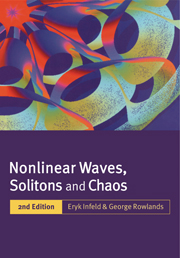Book contents
- Frontmatter
- Contents
- Foreword to the first edition
- Foreword to the second edition
- 1 Introduction
- 2 Linear waves and instabilities in infinite media
- 3 Convective and non-convective instabilities; group velocity in unstable media
- 4 A first look at surface waves and instabilities
- 5 Model equations for small amplitude waves and solitons; weakly nonlinear theory
- 6 Exact methods for fully nonlinear waves and solitons
- 7 Cartesian solitons in one and two space dimensions
- 8 Evolution and stability of initially one-dimensional waves and solitons
- 9 Cylindrical and spherical solitons in plasmas and other media
- 10 Soliton metamorphosis
- 11 Non-coherent phenomena
- Appendices
- References
- Author index
- Subject index
- Plate section
11 - Non-coherent phenomena
Published online by Cambridge University Press: 05 June 2012
- Frontmatter
- Contents
- Foreword to the first edition
- Foreword to the second edition
- 1 Introduction
- 2 Linear waves and instabilities in infinite media
- 3 Convective and non-convective instabilities; group velocity in unstable media
- 4 A first look at surface waves and instabilities
- 5 Model equations for small amplitude waves and solitons; weakly nonlinear theory
- 6 Exact methods for fully nonlinear waves and solitons
- 7 Cartesian solitons in one and two space dimensions
- 8 Evolution and stability of initially one-dimensional waves and solitons
- 9 Cylindrical and spherical solitons in plasmas and other media
- 10 Soliton metamorphosis
- 11 Non-coherent phenomena
- Appendices
- References
- Author index
- Subject index
- Plate section
Summary
Introduction
In the earlier chapters of this book the emphasis has been on a study of the existence and stability of nonlinear waves and solitons, that is of coherent structures. Such structures are found in Nature and thus certainly deserve our attention. However, a much more universal type of behaviour is described under the umbrella of turbulence. One envisages turbulence as a phenomenon where some measurable quantity has a rapid space and/or time dependence. For example, in the case of water passing over a weir, the complicated behaviour is apparent in the local velocity of the water. One sees eddies (or vortices) of a range of sizes. They not only move with some background velocity but also interact with one another to produce a continually changing picture.
For another example, consider turbulence in the wake of a cylinder if the water flow is of very high Reynolds number (see Fig. 1.5(c), (d)).
The problem of trying to understand turbulence has been with us for centuries but it still remains a basic unresolved problem. (The beauty and complexity of turbulence was well appreciated by Leonardo da Vinci as is evidenced in his drawings of vortices in water, Fig. 11.1.)
Somewhat ironically, the study of turbulence in plasmas, which themselves are much more complicated media, is more tractable than in water and considerable progress has been made in the last twenty years. However, most theories to date are restricted in that they assume that the energy in the fluctuations is small compared to the kinetic energy of the particles.
- Type
- Chapter
- Information
- Nonlinear Waves, Solitons and Chaos , pp. 304 - 345Publisher: Cambridge University PressPrint publication year: 2000
- 1
- Cited by

